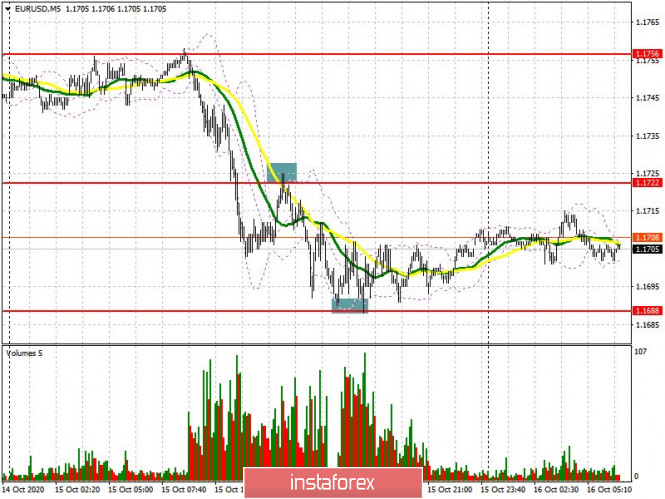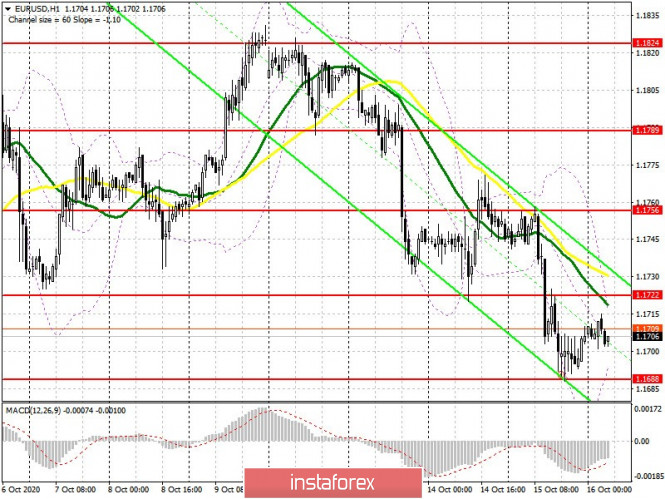
To open long positions on EUR/USD, you need:
Nothing interesting happened yesterday afternoon. The bulls managed to protect support at 1.1688, a signal for buying the euro appeared during the first test, and the bears did not force events and went for a breakout of this range amid weak fundamental indicators on the US labor market.

Nothing has changed from a technical point of view. As long as trading is held above 1.1688, the euro will still have chances to recover. The main goal of buyers is to return to resistance at 1.1722, where the moving averages pass, playing on the side of the seller. Getting the pair to settle at this level creates an additional signal to buy EUR/USD in the hopes of recovering to a high of 1.1756, where I recommend taking profits. If the pair drops to the support of 1.1688, I recommend waiting for a false breakout and divergence on the MACD indicator, which forms a new signal to buy the euro. However, this is only relevant for the first half of the day, since the divergence will be completely covered by the zero value of the indicator closer to the US session. It is best not to rush into buy positions in case of lack of activity at the 1.1688 level and bad eurozone inflation data, instead you should wait the price to fall to the next major support in the 1.1644 region, from which you can buy the euro immediately on a rebound, counting on a correction of 15-20 points within the day...
The Commitment of Traders (COT) report for October 6 showed a reduction in long positions and an increase in short positions, which led to an even greater decrease in the delta. Buyers of risky assets believe in sustaining the bull market, but prefer to proceed with caution, as there is no good news about the eurozone and the pace of economic recovery so far. Thus, long non-commercial positions decreased from 241,967 to 231,369, while short non-commercial positions increased from 53,851 to 57,061. The total non-commercial net position decreased to 174,308, against 188,116 a week earlier. which indicates a wait-and-see attitude of new players. However, bullish sentiments for the euro remain rather high in the medium term.
To open short positions on EUR/USD, you need:
Sellers are focused on support at 1.1688. Poor data on a larger contraction in eurozone inflation and its foreign trade balance will cause the pair to settle below this level. However, you can open short positions there but only if it is tested from the bottom up, similar to yesterday's sell position from 1.1722, which forms a good entry point to short positions in continuing the current trend and with the goal of entering a new low of 1.1644, where I recommend taking profits. However, before you sell, take a close look at the MACD indicator and make sure that there is no divergence. If the bulls are more active in the first half of the day, then you can consider new short positions after forming a false breakout at the 1.1722 level, but I recommend selling the pair immediately on a rebound, but only when the morning high of 1.1756 has been tested, counting on a correction of 15-20 points.

Indicator signals:
Moving averages
Trading is carried out below 30 and 50 moving averages, which indicates that pressure on the euro persists.
Note: The period and prices of moving averages are considered by the author on the H1 hourly chart and differs from the general definition of the classic daily moving averages on the D1 daily chart.
Bollinger Bands
A break of the lower border of the indicator around 1.1690 will increase pressure on the euro and lead to a larger downward movement for the pair. A breakout of the upper border of the indicator in the 1.1722 area will lead to an increase in EUR/USD.
Description of indicators
Moving average (moving average, determines the current trend by smoothing out volatility and noise). Period 50. It is marked in yellow on the chart. Moving average (moving average, determines the current trend by smoothing out volatility and noise). Period 30. It is marked in green on the chart. MACD indicator (Moving Average Convergence/Divergence — convergence/divergence of moving averages) Quick EMA period 12. Slow EMA period to 26. SMA period 9 Bollinger Bands (Bollinger Bands). Period 20 Non-commercial speculative traders, such as individual traders, hedge funds, and large institutions that use the futures market for speculative purposes and meet certain requirements. Long non-commercial positions represent the total long open position of non-commercial traders. Short non-commercial positions represent the total short open position of non-commercial traders. Total non-commercial net position is the difference between short and long positions of non-commercial traders.